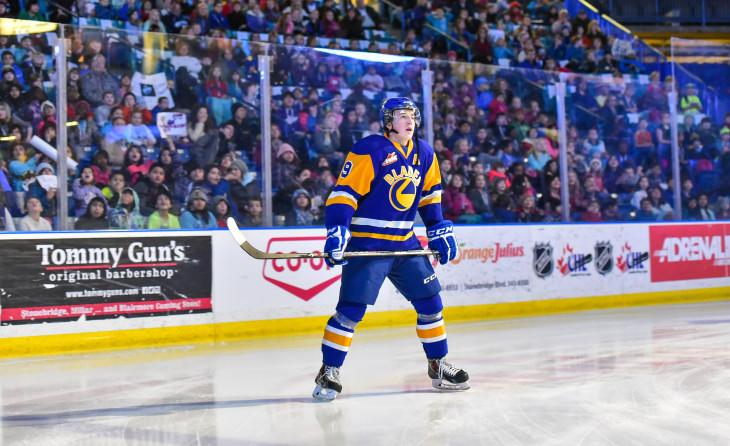The Edmonton Oilers first dipped their toes into the unsigned free agent pool on Thursday, signing 20-year-old Saskatoon Blades centre Cameron Hebig.
In the immediate aftermath, there were many jokes about Oilers general manager Peter Chiarelli being enamoured by the last name or the irony of a 6′ skater having that last name to begin with, but very little on the player himself or what he brings to the Oilers organization.
That’s probably not by mistake. Undrafted free agents usually get to that point for a reason, and the flaws that kept them from hearing their name at the draft mean they’re a supreme long-shot in a sea of low-probability bets.
Every now and then though you can stumble upon a useful NHL contributor, and it’ll set you back naught but the cost of the contract. The Oilers have one such player in their lineup in Drake Caggiula.
I guess the question then is whether the Oilers stumbled upon my wallet or that of a wealthy business person.
With Hebig, as with any prospect, the answer is likely the former of those two. There are reasons, though, to think that Hebig was a relatively sound bet compared to your average undrafted free agent.
For starters, a part of why Hebig was passed over in multiple drafts, I’m certain, has to do with height. He’s grown a fair amount, from 5’10 to 6′ since his first year of draft eligibility. And playing on the Saskatoon Blades, who’ve been stuck near the bottom of the WHL standings for years — it’s hard to look good in those circumstances. Then there’s the matter of an entirely missed season last year, which was his final year of draft eligibility.
Since returning from injury, Hebig’s been the Blades best player this season. He leads the team in scoring with 51 points (28 goals and 23 assists) in 31 games, good for a 1.65 points per game pace. As the chart highlights, Hebig’s done it in every way possible too, from shorthanded goals right on up to the power play. Talk about a jack of all trades.
When we look at how often a player with Hebig’s statistical profile progresses to the NHL, some of that enthusiasm is dampened though. Using the pGPS (prospect graduations probability system) developed by CanucksArmy’s Jeremy Davis, we find that only 6% of the skaters that have shared a similar statistical profile to Hebig’s this season go on to have a successful NHL career.
And when we look at the players from Hebig’s cohort that have gone on to find NHL success, they’re usually in the mould of pugilists or depth forwards, if that.
Hebig’s numbers likely suffer as a result of being in his overage season though. If you make it to your overage season in the CHL, it’s not a good sign, but sometimes otherwise useful players end up caught in that shuffle and their numbers from a projections standpoint suffer for it. That’s likely the case for Hebig, who’s not a face-puncher. And the fact that his projection based metrics were a lot better in his draft-plus-one season, which was his last full season of play, bodes well in that context.
Even so, you’re talking about a prospect with about a one-in-five chance of making it, which isn’t great but is significantly better value-wise than what you’ll get out of your average undrafted free agent.
What does the scouting community think? Well, the www.HockeyProspect.com BlackBook from his draft year doesn’t account for Hebig. In his draft-plus-one year, however, there’s a little nugget of information. Here’s their transcript from 2016.
Hebig is a strong skater with good speed and agility. He has great core strength and balance and is very hard to separate from the puck. Cameron played on a weak Blades team this year and was one of the few bright spots. In his third season in the WHL he has shown very steady progression during this time finishing with 69 points this season. He was relied upon to lead a younger group and was a great example in how he was always well prepared and brought an energy and compete to every game.Hebig was always noticeable whether he was scoring a goal, laying a huge hit or blocking a shot. Cameron plays a fast, high paced game and loves to engage physically on the fore check by using his speed to force turnovers and play the body. He played both on the power play and the penalty kill and other important situations. Hebig played 59 games and had his best offensive output of his career. He is a solid, two way forward that can impact the game in many different ways. He wears his heart on his sleeve and competes hard every shift. He consistently does the little things very well and keeps his game simple and it has paid off for him.
That was two years ago, so it’s perhaps a little out of date, but I think you can still make some assumptions about the style of the player in question, and they are mostly positive. Hebig can skate and plays a responsible game.
Where does he project now? Well, that’s a different question. I asked a friend of mine and a scout of 20-plus years for his take on Hebig. Shane Malloy is the co-host of Hockey Prospect Radio on Sirius XM, and he had this to say on Hebig’s future.
I do not project him anything more than an AHL player but organizations need quality AHL players for their top prospects to play with.
If Hebig can develop into an NHL contributor, as unlikely as that may seem at present, that would be one hell of a found wallet. Then again, finding a useful, relatively young player to help guide your prospects along wouldn’t be the worst outcome either. It sounds like the Oilers will get some kind of return on this investment.

